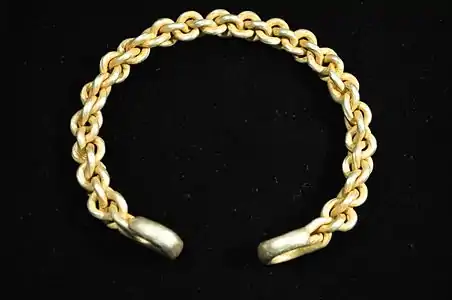| Towton torcs | |
|---|---|
 The second of the two torcs discovered. | |
| Material | Gold, silver, and copper |
| Period/culture | Iron Age Britain |
| Discovered | 2010 and 2011 Towton, North Yorkshire |
| Present location | Yorkshire Museum, York |
| Identification | SWYOR-CFE7F7 |
The Towton torcs are a pair of gold bracelets from Towton, North Yorkshire, England, dating from the later Iron Age.
Discovery
The torcs were found by metal detectorists in a stream in 2010 and 2011.[1]
Description
Both torcs are gold alloys and formed from a twisted wire with looped terminals. The first torc discovered comprised a twisted wire of two strands, the second had four strands. The first torc measured 75.1 millimetres (2.96 in) in diameter, weighed 67.7g. It had a metal content of 80-84% gold; 12-14% silver; and at least 4% copper.[2]
Acquisition and display
After being declared as treasure, the Yorkshire Museum launched a public funding campaign to raise the £60,000 required to purchase the torcs.[3] The torcs were acquired by the museum in November 2013.[1][4]
References
- 1 2 "Yorkshire Museum buys second Towton bracelet". BBC News. 28 November 2013. Retrieved 20 January 2021.
- ↑ "BRACELET (SWYOR-CFE7F7)". Portable Antiquities Scheme. Retrieved 20 January 2021.
- ↑ "Appeal to keep Towton Iron Age treasure in Yorkshire". BBC News. 22 November 2011. Retrieved 20 January 2021.
- ↑ "Yorkshire Museum buys £30,000 Iron Age torc after public appeal succeeds". Culture24. 28 November 2013. Retrieved 20 January 2021.
External links
This article is issued from Wikipedia. The text is licensed under Creative Commons - Attribution - Sharealike. Additional terms may apply for the media files.